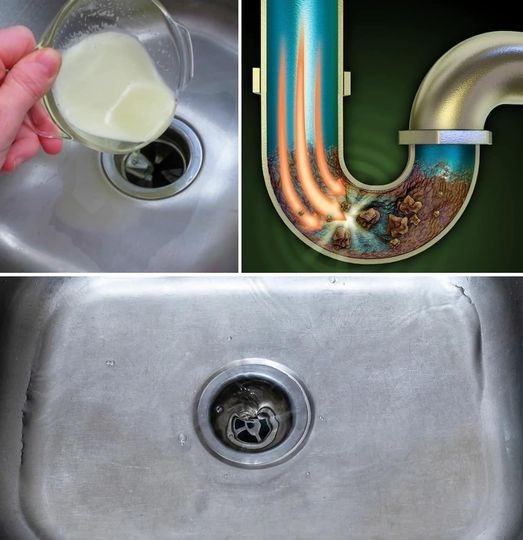ADVERTISEMENT
Step 1: Pour Baking Soda into the Drain
Start by pouring half a cup of baking soda directly into the clogged drain. Baking soda is a fantastic natural cleaner and deodorizer. It will work on breaking down grease, soap scum, and other organic materials that may be causing the blockage.
Step 2: Add Vinegar for a Fizzy Reaction
Next, pour one cup of white vinegar into the drain. The combination of baking soda and vinegar creates a fizzy reaction that helps loosen debris and break down grime. This natural reaction will help dissolve buildup in your pipes without harsh chemicals.
Step 3: Cover the Drain and Wait
After adding the vinegar, quickly cover the drain with a plug or cloth to trap the reaction inside. Let the mixture sit and fizz for about 10 to 15 minutes. This allows the powerful combination of baking soda and vinegar to work its magic on the buildup inside the pipes.
Step 4: Pour Hot Water Down the Drain
After waiting for the fizzing to subside, boil about two liters of water. Carefully pour the hot water down the drain. The heat helps to flush away the loosened debris, leaving your pipes clean and clear.
Step 5: Repeat if Necessary
If the clog is stubborn, repeat the process one more time. For particularly tough clogs, you can also add 1-2 tablespoons of salt to the baking soda to increase the abrasive action, which can help scrub away more stubborn buildup.
Step 6: Use a Plunger (Optional)
If the water still isn’t draining properly after the above steps, you can try using a plunger. Just ensure there’s enough water in the sink or tub to cover the plunger’s cup, then use it to create a vacuum effect. Push and pull vigorously a few times to dislodge the clog. You’d be surprised how often this can finish the job!
Step 7: Flush with More Hot Water
Once the clog is gone, give your drain a final flush with more hot water to ensure everything is flowing smoothly.
Why This Trick Works
Baking soda and vinegar are often referred to as a “magic cleaning duo” because they work together to break down grease, soap scum, and even hair in your pipes. The baking soda acts as a mild abrasive that loosens debris, while the vinegar dissolves buildup, leaving your drain cleaner and fresher than before.
Hot water helps to push out any remaining particles that might have been loosened by the fizzy reaction. And if you add salt, the abrasive action helps scrub away even more stubborn clogs.
Tips for Maintaining Clear Drains:
- Regular cleaning: Make this method a routine! If you clean your drains once a month, you’ll prevent clogs from building up in the first place.
- Be mindful of what goes down the drain: Avoid pouring grease, oil, or food scraps down the drain. Over time, these can build up and create major blockages.
- Use a drain guard: A simple drain guard can prevent hair and debris from going down the drain, reducing the chances of clogs.
When to Call a Plumber
While this natural method works wonders for most minor clogs, there are instances when you may need to call a professional plumber:
- If the clog persists after trying this method multiple times.
- If you notice slow drainage that happens in multiple fixtures (which may indicate a larger issue in the plumbing system).
- If you encounter foul odors or notice standing water that doesn’t seem to clear up.
Conclusion
With this home trick to clean your drain and pipes, you can save money, avoid harsh chemicals, and keep your plumbing in great shape. This easy-to-follow, all-natural method will have your drains running smoothly in no time, without the need for expensive plumber visits. So, the next time you encounter a clogged drain, try this DIY trick first—you’ll be amazed at how well it works!
